- Recent Articles
- Most Citedi
- Most Visitedi
- Future Articles
-
Resumos de Teses06-19-2002
Linfonodo Sentinela no Carcinoma Infiltrativo Inicial de Mama: Estudo de sua Localização e de sua Capacidade Preditiva em Relação ao Estado da Axila
Revista Brasileira de Ginecologia e Obstetrícia. 2002;24(1):69-69
Abstract
Resumos de TesesLinfonodo Sentinela no Carcinoma Infiltrativo Inicial de Mama: Estudo de sua Localização e de sua Capacidade Preditiva em Relação ao Estado da Axila
Revista Brasileira de Ginecologia e Obstetrícia. 2002;24(1):69-69
DOI 10.1590/S0100-72032002000100014
Views38Linfonodo Sentinela no Carcinoma Infiltrativo Inicial de Mama: Estudo de sua Localização e de sua Capacidade Preditiva em Relação ao Estado da Axila […]See more

This is an Open Access article distributed under the terms of the Creative Commons Attribution License, which permits unrestricted use, distribution, and reproduction in any medium, provided the original work is properly cited. -
Resumos de Teses06-19-2002
Avaliação da Função Ovariana Pós-histerectomia Total Abdominal em Mulheres no Menacme
Revista Brasileira de Ginecologia e Obstetrícia. 2002;24(1):69-69
Abstract
Resumos de TesesAvaliação da Função Ovariana Pós-histerectomia Total Abdominal em Mulheres no Menacme
Revista Brasileira de Ginecologia e Obstetrícia. 2002;24(1):69-69
DOI 10.1590/S0100-72032002000100013
Views76Avaliação da Função Ovariana Pós-histerectomia Total Abdominal em Mulheres no Menacme […]See more

This is an Open Access article distributed under the terms of the Creative Commons Attribution License, which permits unrestricted use, distribution, and reproduction in any medium, provided the original work is properly cited. -
Resumos de Teses06-19-2002
Efeitos do Tabagismo na Circulação Arterial Materna e Fetal: Estudo Através do Método Doppler
Revista Brasileira de Ginecologia e Obstetrícia. 2002;24(1):68-68
Abstract
Resumos de TesesEfeitos do Tabagismo na Circulação Arterial Materna e Fetal: Estudo Através do Método Doppler
Revista Brasileira de Ginecologia e Obstetrícia. 2002;24(1):68-68
DOI 10.1590/S0100-72032002000100012
Views52Efeitos do Tabagismo na Circulação Arterial Materna e Fetal: Estudo Através do Método Doppler […]See more

This is an Open Access article distributed under the terms of the Creative Commons Attribution License, which permits unrestricted use, distribution, and reproduction in any medium, provided the original work is properly cited. -
Resumos de Teses06-19-2002
Terapia com Raloxifeno na Pós-menopausa: Efeitos sobre o Sistema Hemostático
Revista Brasileira de Ginecologia e Obstetrícia. 2002;24(1):67-67
Views44

This is an Open Access article distributed under the terms of the Creative Commons Attribution License, which permits unrestricted use, distribution, and reproduction in any medium, provided the original work is properly cited. Abstract
Resumos de TesesTerapia com Raloxifeno na Pós-menopausa: Efeitos sobre o Sistema Hemostático
Revista Brasileira de Ginecologia e Obstetrícia. 2002;24(1):67-67


This is an Open Access article distributed under the terms of the Creative Commons Attribution License, which permits unrestricted use, distribution, and reproduction in any medium, provided the original work is properly cited. -
Resumos de Teses06-19-2002
Efeitos da Metiltestosterona sobre a Sexualidade, Metabolismo Lipoproteíco e Hepático e Níveis de Testosterona em Mulheres na Pós-Menopausa em Uso de Reposição Estroprogestativa
Revista Brasileira de Ginecologia e Obstetrícia. 2002;24(1):67-68
Abstract
Resumos de TesesEfeitos da Metiltestosterona sobre a Sexualidade, Metabolismo Lipoproteíco e Hepático e Níveis de Testosterona em Mulheres na Pós-Menopausa em Uso de Reposição Estroprogestativa
Revista Brasileira de Ginecologia e Obstetrícia. 2002;24(1):67-68
DOI 10.1590/S0100-72032002000100011
Views53Efeitos da Metiltestosterona sobre a Sexualidade, Metabolismo Lipoproteíco e Hepático e Níveis de Testosterona em Mulheres na Pós-Menopausa em Uso de Reposição Estroprogestativa […]See more

This is an Open Access article distributed under the terms of the Creative Commons Attribution License, which permits unrestricted use, distribution, and reproduction in any medium, provided the original work is properly cited. -
Original Article06-19-2002
Knowledge and Opinion of Brazilian Researchers About Informed Consent
Revista Brasileira de Ginecologia e Obstetrícia. 2002;24(1):59-65
Views86

This is an Open Access article distributed under the terms of the Creative Commons Attribution License, which permits unrestricted use, distribution, and reproduction in any medium, provided the original work is properly cited. Abstract
Original ArticleKnowledge and Opinion of Brazilian Researchers About Informed Consent
Revista Brasileira de Ginecologia e Obstetrícia. 2002;24(1):59-65
DOI 10.1590/S0100-72032002000100009
Views86Introduction: the Resolution 196/96 of the Conselho Nacional de Saúde (National Council of Health/Ministry of Health) presents the main Brazilian guidelines on research involving human subjects, including the content of written informed consent. Purpose: to present the knowledge and opinion of Brazilian researchers on the contents of Resolution 196/96, specifically related to the informed consent form. Subjects and methods: forty-six doctors responsible for the area of gynecology at Brazilian universities, four directors of research centers and 31 researchers who participated in a study related to fertility regulation during the 12 months preceding September, 2000. Subjects completed a self-reporting questionnaire. Data were analyzed by the chi² test. Results: most subjects declared that they knew the Resolution 196/96 and considered it adequate, although difficult to comply with; they considered that all studies should have an informed consent form, and knew that its content should guarantee confidentiality. More researchers than those responsible for gynecology department/directors knew that the informed consent form should be prepared by the principal investigator. Significantly more responsible for gynecology department/directors than researchers declared that subjects must always sign (or put their thumb print if they do not know how to write) on the informed consent form. Subjects declared that payment of expenses resulting from participation in a study must always be explained in the informed consent form. Conclusion: despite the wide dissemination of the Resolution 196/96, it was not known by all the researchers nor by all those responsible for gynecology departament/directors. The majority agreed with the contents required by the Resolution for the informed consent form.
Key-words Ethics CommitteeInformed consentSee more

This is an Open Access article distributed under the terms of the Creative Commons Attribution License, which permits unrestricted use, distribution, and reproduction in any medium, provided the original work is properly cited. -
Original Article06-19-2002
p53 Protein Overexpression as a Prognostic Marker for Vulvar Intraepithelial Neoplasia III Recurrence/Progression
- Isabel Cristina Chulvis do Val Guimarães,
- Gutemberg Leão de Almeida Filho,
- Maria da Glória de Carvalho,
- Christina Maeda Takiya,
- Aldo Franklin Ferreira Reis, [ … ],
- Maria Consuelo Gondim
Abstract
Original Articlep53 Protein Overexpression as a Prognostic Marker for Vulvar Intraepithelial Neoplasia III Recurrence/Progression
Revista Brasileira de Ginecologia e Obstetrícia. 2002;24(1):51-57
DOI 10.1590/S0100-72032002000100008
- Isabel Cristina Chulvis do Val Guimarães,
- Gutemberg Leão de Almeida Filho,
- Maria da Glória de Carvalho,
- Christina Maeda Takiya,
- Aldo Franklin Ferreira Reis,
- Paulo Marcos Valiante,
- Maria Consuelo Gondim
Views160See morePurpose: to evaluate p53 overexpression value in vulvar intraepithelial neoplasia (VIN) III recurrence/progression. Methods: twenty patients with undifferentiated VIN III were selected and followed up every six months for four years and divided into two groups: fourteen without and six with recurrence/progression lesion. The recurrence/progression cases were distributed as follows: in three patients recurrence occurred only once; in two, twice, and only one progressed to squamous cancer. In both groups the site of vulvar lesion and p53 overexpression and immunostaining pattern were analyzed. A similar study was performed in recurrence/progression cases, besides the analysis of the time interval to occur the arise of recurrence/progression. Results: recurrence was observed in 25% of the cases and, in 5%, progression to carcinoma. The mean time interval for recurrence was 24.5 months. Multifocal location of the initial lesion was the predominant form (50%) in both groups. In the majority of the cases (87.5%) recurrence/progression occurred at the same site of the initial vulvar lesion. p53 overexpression was observed in 50% of the VIN III primary lesions and in 75% of the recurrence/progression cases. Conclusions: p53 overexpression seems to play an important role in VIN III pathogenesis and may predict the clinical course of the lesions. VIN III recurrence/progression has a tendency to occur in the same area of the initial lesion, suggesting the presence of molecular disturbance.


This is an Open Access article distributed under the terms of the Creative Commons Attribution License, which permits unrestricted use, distribution, and reproduction in any medium, provided the original work is properly cited. -
Original Article06-19-2002
Endometrial Adenocarcinoma Frequency in a Hysteroscopy Outpatient Clinic: A Multicenter Study
- Francesco Antonio Viscomi,
- Sonia Maria Rolim Rosa Lima,
- José Mendes Aldrighi,
- Mauro Fernando Kürten Ihlenfeld
Views94

This is an Open Access article distributed under the terms of the Creative Commons Attribution License, which permits unrestricted use, distribution, and reproduction in any medium, provided the original work is properly cited. Abstract
Original ArticleEndometrial Adenocarcinoma Frequency in a Hysteroscopy Outpatient Clinic: A Multicenter Study
Revista Brasileira de Ginecologia e Obstetrícia. 2002;24(1):45-50
DOI 10.1590/S0100-72032002000100007
- Francesco Antonio Viscomi,
- Sonia Maria Rolim Rosa Lima,
- José Mendes Aldrighi,
- Mauro Fernando Kürten Ihlenfeld
Views94Purpose: to perform a census about the frequency of endometrial adenocarcinoma of women submitted to diagnostic hysteroscopy in five Brazilian hysteroscopic centers in São Paulo, Rio de Janeiro, Salvador, Caxias do Sul and Porto Alegre. Methods: information was collected from standard questionnaires about the presence of endometrial adenocarcinoma, hysteroscopic staging and histologic type, in pre- and postmenopausal women. Results: among 6,466 hysteroscopic procedures, endometrial adenocarcinoma was present in 92 patients (1.4%), confirmed by histology in 79 (1.2%) cases. For the hysteroscopic diagnosis of endometrial adenocarcinoma confirmed by histology, a sensitivity of 85.9%, specificity of 100%, positive predictive value of 100% and negative predictive value of 98.6% were obtained. In the premenopausal group, among 3,845 hysteroscopic exams, endometrial cancer was present in 83 (3.2%) and confirmed by histology in 71 cases (2.7%). Conclusions: this study points out the importance of epidemiological methods in the diagnostic and prevention programs of endometrial cancer, specially in postmenopause, revealing the need for further epidemiological studies on endometrial adenocarcinoma diagnostis and prevention programs.
Key-words Cancer screeningEndometrial neoplasmsEndometrial neoplasms, epidemiologyEndometrial neoplasms, histologyHysteroscopySee more

This is an Open Access article distributed under the terms of the Creative Commons Attribution License, which permits unrestricted use, distribution, and reproduction in any medium, provided the original work is properly cited.
-
Review Article03-18-2025
Efficacy of vitamin C supplementation during pregnancy in the prevention of preterm birth: a systematic review and meta-analysis
- Ana Gabriela Alves Pereira
 ,
, - Gabriela Oliveira Gonçalves Molino
 ,
, - Ana Clara Felix de Farias Santos
 ,
, - Maírla Marina Ferreira Dias
 ,
, - Nicole dos Santos Pimenta
 , [ … ],
, [ … ], - Pedro Henrique Costa Matos da Silva

Abstract
Review ArticleEfficacy of vitamin C supplementation during pregnancy in the prevention of preterm birth: a systematic review and meta-analysis
Revista Brasileira de Ginecologia e Obstetrícia. 2025;47:e-rbgo1
- Ana Gabriela Alves Pereira
 ,
, - Gabriela Oliveira Gonçalves Molino
 ,
, - Ana Clara Felix de Farias Santos
 ,
, - Maírla Marina Ferreira Dias
 ,
, - Nicole dos Santos Pimenta
 ,
, - Pedro Henrique Costa Matos da Silva

Views129Abstract
Objective:
Preterm birth is a leading global cause of neonatal mortality and morbidity, with oxidative stress playing a role in its pathogenesis. Vitamin C, a powerful antioxidant, may help reduce this risk. This study assessed the effectiveness of vitamin C supplementation, both alone and with vitamin E, in preventing preterm birth compared to a placebo.
Data source:
Databases were systematically searched in PubMed, Cochrane and Embase in December 2023 and updated in May 2024.
Study Selection:
Included RCTs evaluated vitamin C’s effect on preterm birth and related neonatal outcomes.
Data collect:
Statistical analyses used a random-effects model for pooled risk ratios (RR) and 95% confidence intervals (CI). Heterogeneity was assessed with the I² statistic.
Data synthesis:
Seventeen RCTs (21,567 patients) were analyzed. Vitamin C supplementation showed no significant difference compared to placebo for preterm birth (RR 1.04; 95% CI 0.96, 1.14). No significant differences were observed for neonatal death (RR 0.77; 95% CI 0.55, 1.08), NICU admission (RR 1.03; 95% CI 0.95, 1.13), preterm PROM (RR 1.04; 95% CI 0.63, 1.71), or birth weight (MD 52.41; 95% CI −19.65, 124.47). A slight decrease in gestational age was observed (MD 0.26; 95% CI −0.02, 0.55).
Conclusion:
Vitamin C supplementation alone or in combination with vitamin E does not significantly prevent preterm birth or improve related neonatal outcomes.
Key-words Ascorbic acidFetal membranes, premature ruptureGestational ageIntensive care units, neonatalPregnancyPremature birthVitamin C supplementationVitamin ESee more

This is an Open Access article distributed under the terms of the Creative Commons Attribution License, which permits unrestricted use, distribution, and reproduction in any medium, provided the original work is properly cited. 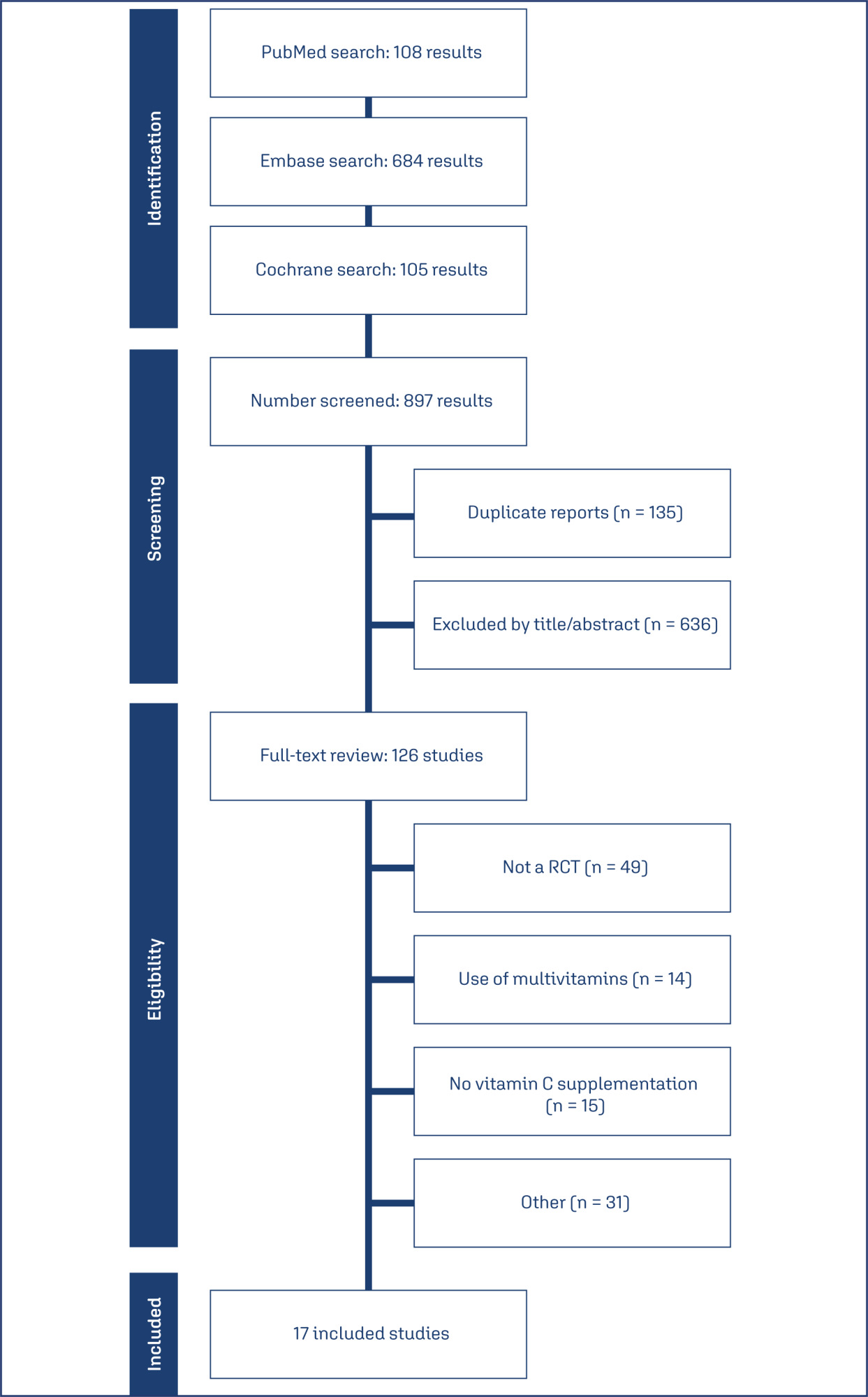
- Ana Gabriela Alves Pereira
-
FEBRASGO POSITION STATEMENT03-18-2025
Use of synthetic slings in the treatment of female stress urinary incontinence: Number 2 – 2025
- Marair Gracio Ferreira Sartori
 ,
, - Marilene Vale de Castro Monteiro
 ,
, - Cássia Raquel Teatin Juliato
 ,
, - Luiz Gustavo Oliveira Brito
 ,
, - Sergio Brasileiro Martins
 , [ … ],
, [ … ], - Emerson de Oliveira

Abstract
FEBRASGO POSITION STATEMENTUse of synthetic slings in the treatment of female stress urinary incontinence: Number 2 – 2025
Revista Brasileira de Ginecologia e Obstetrícia. 2025;47:e-FPS2
- Marair Gracio Ferreira Sartori
 ,
, - Marilene Vale de Castro Monteiro
 ,
, - Cássia Raquel Teatin Juliato
 ,
, - Luiz Gustavo Oliveira Brito
 ,
, - Sergio Brasileiro Martins
 ,
, - José Miguel de Deus
 ,
, - Ana Selma Bertelli Picoloto
 ,
, - Jorge Milhem Haddad
 ,
, - Andreisa Paiva Monteiro Bilhar
 ,
, - Leticia Maria de Oliveira
 ,
, - Rafael Mendes Moroni
 ,
, - Lucas Schreiner
 ,
, - Aljerry Dias do Rego
 ,
, - Daniela Siqueira Prado
 ,
, - Emerson de Oliveira



This is an Open Access article distributed under the terms of the Creative Commons Attribution License, which permits unrestricted use, distribution, and reproduction in any medium, provided the original work is properly cited. - Marair Gracio Ferreira Sartori
-
Original Article02-13-2025
Anemia levels in the preconception period and the first trimester of pregnancy: a national, multicentric and cross-sectional study
- Aytaj Jafarzade
 ,
, - Veli Mi̇hmanli
 ,
, - And Yavuz
 ,
, - Murat Akbaş
 ,
, - Gürcan Türkyilmaz
 , [ … ],
, [ … ], - Muhittin Tamer Mungan

Abstract
Original ArticleAnemia levels in the preconception period and the first trimester of pregnancy: a national, multicentric and cross-sectional study
Revista Brasileira de Ginecologia e Obstetrícia. 2025;47:-e-rbgo1001
DOI 10.61622/rbgo/2025rbgo10001
- Aytaj Jafarzade
 ,
, - Veli Mi̇hmanli
 ,
, - And Yavuz
 ,
, - Murat Akbaş
 ,
, - Gürcan Türkyilmaz
 ,
, - Esra Nur Özkan
 ,
, - Murat İbrahim Toplu
 ,
, - Yücel Kaya
 ,
, - Damla Yasemin Yenli̇k Kaya
 ,
, - Mustafa Yildiz
 ,
, - Ali Emre Ati̇k
 ,
, - Elif İlgazi̇ Kiliç
 ,
, - Burcu Özata
 ,
, - Sehtap Nazlı Kiliç Çeti̇n
 ,
, - Berk Bulut
 ,
, - Halide Gül Okuducu Aydin
 ,
, - Lale Aslanova
 ,
, - Çağdaş Nurettin Emekli̇oğlu
 ,
, - Melike Eren
 ,
, - Elif Uçar
 ,
, - Kaan Eray Uzun
 ,
, - Osman Ufuk Eki̇z
 ,
, - Muhittin Tamer Mungan

Views283Abstract
Objective
The study aimed to determine the level of anemia in pregnant women in the first trimester and in the preconception period by conducting nationwide research.
Methods
The study was designed as retrospective, cross-sectional, and multicenter research. A total of 17 centers from 13 provinces were included in the study. The study was conducted with the participation of two groups of patients who applied to the obstetrics polyclinic between 1 January 2023 and 1 July 2023, who were in the first trimester of pregnancy and who were in the preconception period planning pregnancy.
Results
In total 4,265 women were included in the study. Of these women, 3,884 (91%) were in the first trimester of their pregnancy and 381 (9%) were in the preconception period. Anemia was detected in 24.1% (n=1030) of the patients. Of these patients, 20.6% (n=877) were pregnant women in the first trimester and 3.6% (n=153) were in the preconception period. A statistically significant and positive relationship was found between anemia and meat consumption frequency, educational status, and socioeconomic status of the patients (p=0.000, p=0.000, p=0.000). In addition, a statistically significant and negative correlation was determined between anemia and the number of pregnancies and the parity number (p=0.001, p=0.000) in both groups.
Conclusion
Anemia is a public health problem. Anemia has been determined to be an important problem both in the preconception period and early periods of pregnancy. It is necessary to revise the programs and interventions to reduce the prevalence of anemia and redesign them in line with current conditions.
Key-words Anemia, iron-deficiencypreconception carePregnancy complications, hematologicPregnancy trimester, firstSee more

This is an Open Access article distributed under the terms of the Creative Commons Attribution License, which permits unrestricted use, distribution, and reproduction in any medium, provided the original work is properly cited. 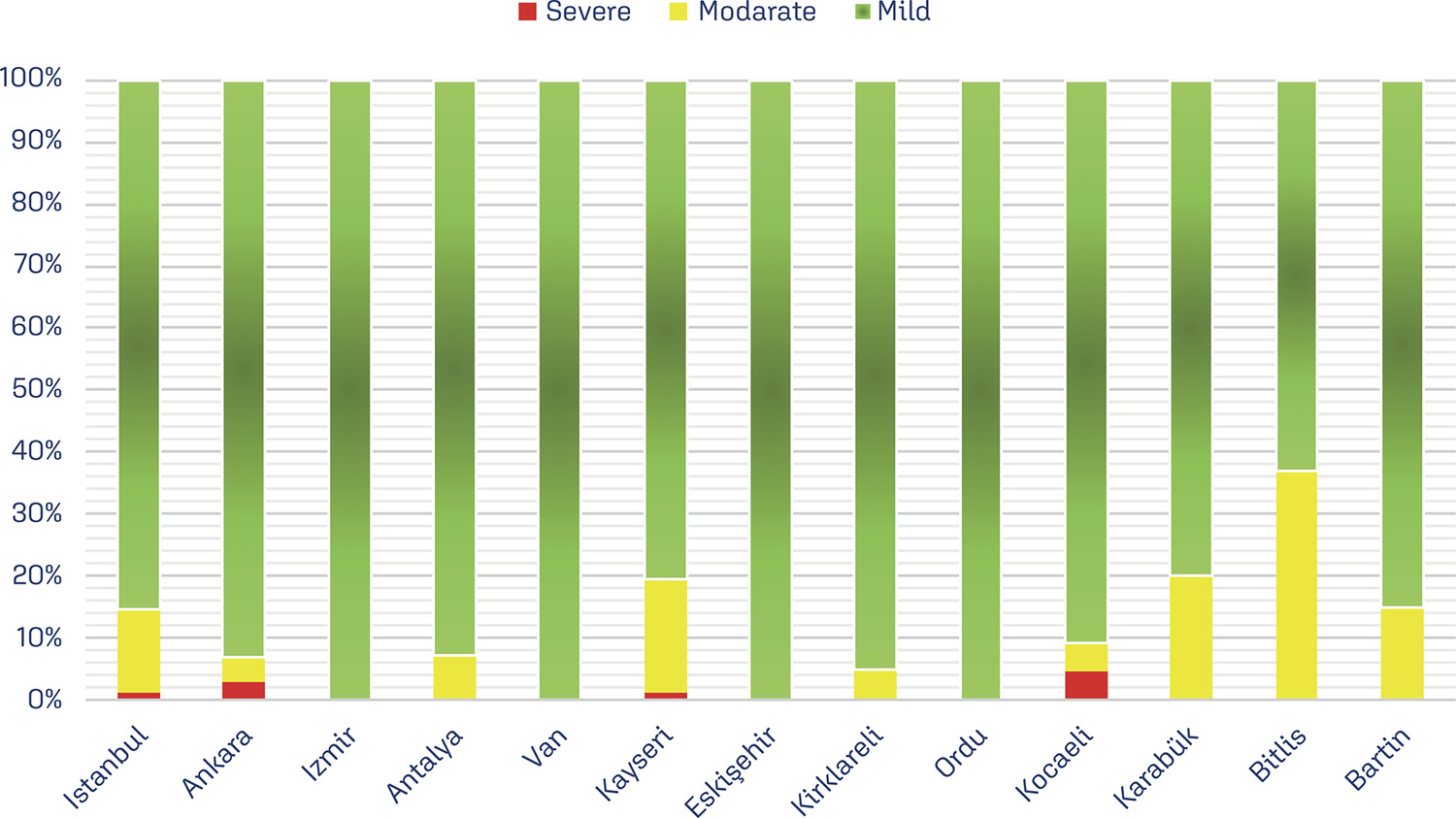
- Aytaj Jafarzade
-
FEBRASGO POSITION STATEMENT02-06-2025
Menopause in gynecologic cancer survivors: evidence for decision-making
- Agnaldo Lopes da Silva Filho
 ,
, - Mariana Seabra Leite Praça
 ,
, - Rívia Mara Lamaita
 ,
, - Eduardo Batista Cândido
 ,
, - Lucia Helena Simões da Costa Paiva
 , [ … ],
, [ … ], - Maria Celeste Osório Wender

Abstract
FEBRASGO POSITION STATEMENTMenopause in gynecologic cancer survivors: evidence for decision-making
Revista Brasileira de Ginecologia e Obstetrícia. 2025;47:e-FPS1
- Agnaldo Lopes da Silva Filho
 ,
, - Mariana Seabra Leite Praça
 ,
, - Rívia Mara Lamaita
 ,
, - Eduardo Batista Cândido
 ,
, - Lucia Helena Simões da Costa Paiva
 ,
, - José Maria Soares Júnior
 ,
, - Renato Moretti Marques
 ,
, - Maria Celeste Osório Wender

Views252See moreKey points
• Although advances in the treatment of gynecological cancer have improved survival rates, they may also increase the effects of induced menopause, especially in young women.
• Cancer treatments such as oophorectomy, gonadotoxic chemotherapy, and pelvic radiotherapy can induce menopause.
• Gonadotoxic chemotherapy, especially alkylating-containing regimens, often damages ovarian function and may result in permanent menopause.
• Pelvic radiotherapy usually results in permanent loss of ovarian function unless ovarian transposition is performed.
• Diagnosing menopause after cancer is challenging, and common diagnostic criteria such as 12 months or more of amenorrhea and elevated follicle-stimulating hormone (FSH) levels are not entirely reliable, since ovarian function may return years after treatment.
• A multidisciplinary approach to post-cancer menopause is essential and should include an appropriate line of care, since hormone replacement therapy after treatment of gynecologic malignancy is controversial.


This is an Open Access article distributed under the terms of the Creative Commons Attribution License, which permits unrestricted use, distribution, and reproduction in any medium, provided the original work is properly cited. 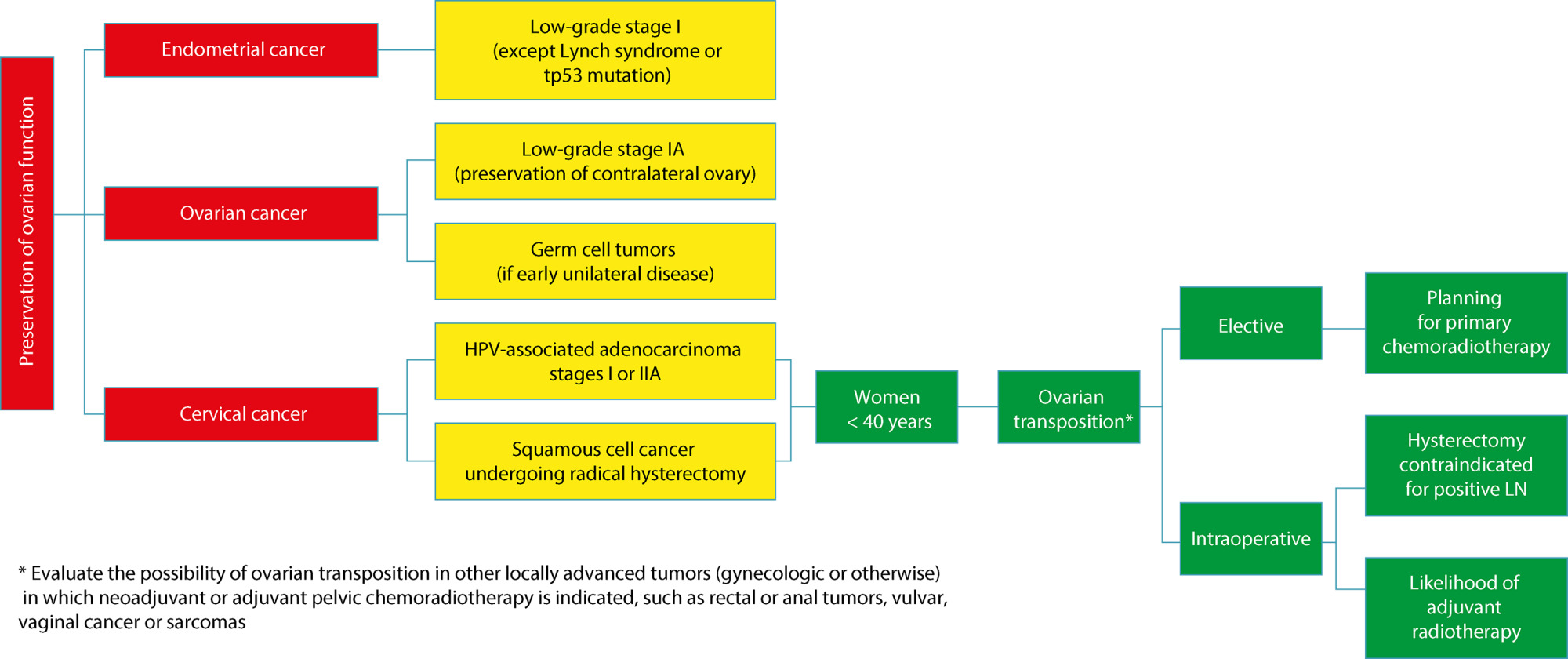
- Agnaldo Lopes da Silva Filho
-
Original Article01-23-2025
Therapeutic resources used by physiotherapists for the relief of labor pain: a cross-sectional study
- Alessandra de Campos Gonçalves
 ,
, - Giovana Garçoni Poli
 ,
, - Clara Maria de Araujo Silva
 ,
, - Ana Carolina Sartorato Beleza
 ,
, - Richard Eloin Liebano

Abstract
Original ArticleTherapeutic resources used by physiotherapists for the relief of labor pain: a cross-sectional study
Revista Brasileira de Ginecologia e Obstetrícia. 2025;47:e-rbgo99
- Alessandra de Campos Gonçalves
 ,
, - Giovana Garçoni Poli
 ,
, - Clara Maria de Araujo Silva
 ,
, - Ana Carolina Sartorato Beleza
 ,
, - Richard Eloin Liebano

Views261Abstract
Objective
The aim of the study was to identify non-pharmacological therapeutic resources used by physiotherapists for pain relief during labor and childbirth.
Methods
This is a cross-sectional study conducted from January to March 2021, followed the STROBE guidelines. It included Brazilian physiotherapists with a minimum of two years in obstetric care experience. Data were collected using a 33-item online questionnaire, which covered sociodemographic details and the utilization of non-pharmacological resources. Descriptive analysis was used to determine participant characteristics. Associations between sociodemographic variables, specialist titles, participation in scientific events, and methods for pain relief methods during childbirth were assessed using chi-square or Fisher’s exact tests. Data were analyzed using SPSS version 23.0, with a significance level set at 5% (p < 0.05).
Results
A total of 114 Brazilian physiotherapists participated in this study. Participants chose to utilize non-pharmacological therapies and resources that are within the scope of physiotherapists’ practice for labor pain. Kinesiotherapy with the use of devices was the most employed technique for pain relief during the birthing process.
Conclusion
The study highlights the prevalent use of non-pharmacological therapeutic resources, particularly kinesiotherapy with devices, among Brazilian physiotherapists for labor pain relief.
Key-words childbirthlabor painLabor, obstetricNon-pharmacological resourcespain managementParturiationPhysical therapistsPregnancysurveys and questionnairesSee more

This is an Open Access article distributed under the terms of the Creative Commons Attribution License, which permits unrestricted use, distribution, and reproduction in any medium, provided the original work is properly cited. - Alessandra de Campos Gonçalves
-
Original Article01-23-2025
Maternal erythrocytosis as a risk factor for small for gestational age at term in high altitude
- Wilfredo Villamonte-Calanche
 ,
, - Marco Antonio Salazar-Zegarra
 ,
, - Cleto De-la-Torre-Dueñas
 ,
, - Alexandra Villamonte-Jerí
 ,
, - Adaí Vera-Luza
 , [ … ],
, [ … ], - Nuria Huanca-Huirse

Abstract
Original ArticleMaternal erythrocytosis as a risk factor for small for gestational age at term in high altitude
Revista Brasileira de Ginecologia e Obstetrícia. 2025;47:e-rbgo98
- Wilfredo Villamonte-Calanche
 ,
, - Marco Antonio Salazar-Zegarra
 ,
, - Cleto De-la-Torre-Dueñas
 ,
, - Alexandra Villamonte-Jerí
 ,
, - Adaí Vera-Luza
 ,
, - Milagros Hilari Bustinza-Apaza
 ,
, - Nuria Huanca-Huirse

Views257Abstract
Objective
To determine if maternal erythrocytosis is a risk factor for small-for-gestational age at term at 3,400-m altitude in pregnant women without intercurrent disease.
Methods
Analytical study of retrospective cohorts at Cusco, a city at 3,400-m altitude. Our participants were 224 and 483 pregnant women with and without exposure to maternal erythrocytosis, respectively. A logistic regression with the goodness of fit to the proposed model was also performed with the Hosmer and Lemeshow test, evaluating the small-for-gestational-age results with or without exposure to hemoglobin >14.5 g/dl.
Results
The incidence of small-for-gestational-age was 6.9% for this entire cohort. The maternal erythrocytosis during gestation without any maternal morbidity at 3,400-m altitude has an ORa=0.691 (p=0.271) for small-for-gestational-age at term. Inadequate prenatal control has an ORa=2.115 (p=0.016) for small-for-gestational-age compared to adequate prenatal control.
Conclusion
Maternal erythrocytosis in pregnant women without any morbidity is not a risk factor for small-for-gestational-age at 3,400 m-altitude.
Key-words AltitudeFetal growth retardationGestational agehemoglobinHypoxiaMorbidityNeonatal mortalityPolycythemiaPregnancyPregnant womenRisk factorssmall for gestational ageSee more

This is an Open Access article distributed under the terms of the Creative Commons Attribution License, which permits unrestricted use, distribution, and reproduction in any medium, provided the original work is properly cited. - Wilfredo Villamonte-Calanche
-
Original Article01-23-2025
Comparison of serum ischemia modified albumin levels between preeclamptic and healthy pregnant women
- Dinç Zuhal
 ,
, - Çakar Erbil
 ,
, - Kumru Pınar
 ,
, - Erel Özcan
 ,
, - Neşelioğlu Salim
 , [ … ],
, [ … ], - Boz Gizem

Abstract
Original ArticleComparison of serum ischemia modified albumin levels between preeclamptic and healthy pregnant women
Revista Brasileira de Ginecologia e Obstetrícia. 2025;47:e-rbgo97
Views310See moreAbstract
Objective
Our aims to compare level of serum ischemia modified albümin(IMA) between healthy and preeclamptic pregnancies and to evaluate the relationship of IMA with preeclampsia, preeclampsia severity and perinatal outcomes.
Methods
Our study is a prospective case-control study. A total of 134 pregnant women (66 preeclamptic and 68 healthy pregnant) between 18-45 years of age and between 24- 41 gestational weeks participated. Serum IMA levels were measured by the Albumin Cobalt Binding (ACB) test.
Results
The mean IMA values were found to be significantly higher in the preeclampsia group compared to the control group (p<0,001). Patients were divided into 3 groups; severe preeclampsia(n=29), non-severe preeclampsia(n=37) and healthy pregnant(n=68). Statistically significant difference was not found between severe preeclampsia and non-severe preeclampsia (p=0.505). The performance of IMA values in predicting the development of preeclampsia among all participants was evaluated with Receiver Operating Characteristic (ROC) analysis. According to the ROC analysis, the best cut-off value at which the maximum area under the curve (AUC) was obtained was found when IMA>0.98(AUC: 0.690 95% Confidence Interval (CI): 0.600-0.781 p<0.001). When IMA threshold value of >0.98 was taken to predict preeclampsia; the sensitivity, specificity, positive predictive value (PPV) and negative predictive value (NPV) were calculated as 65.15%, 64.71%, 64.18%, and 65.67%, respectively.
Conclusion
IMA level may be a useful new marker in recognizing and predicting preeclampsia. However, despite the power of recognizing the disease, serum IMA levels do not give an idea about the severity of the disease. More comprehensive studies are needed in order to use IMA levels in the diagnosis of preeclampsia.


This is an Open Access article distributed under the terms of the Creative Commons Attribution License, which permits unrestricted use, distribution, and reproduction in any medium, provided the original work is properly cited. - Dinç Zuhal
-
Original Article01-23-2025
A comparison of the efficacy of the effect of online versus face-to-face group counseling based on positive-approach on sexual intimacy of women after benign abdominal hysterectomy: a clinical trial
Revista Brasileira de Ginecologia e Obstetrícia. 2025;47:e-rbgo102
Abstract
Original ArticleA comparison of the efficacy of the effect of online versus face-to-face group counseling based on positive-approach on sexual intimacy of women after benign abdominal hysterectomy: a clinical trial
Revista Brasileira de Ginecologia e Obstetrícia. 2025;47:e-rbgo102
Views252See moreAbstract
Objective
The study investigates the influence of positive-approach counseling through both online and face-to-face group therapy on the sexual intimacy of women after benign complete abdominal hysterectomy, addressing challenges such as the loss of femininity and other psychosexual complications that disrupt the couple’s relationship post-surgery.
Methods
This is a parallel clinical trial, conducted in 2023 in Yazd, Iran; with sixty-six participants post- benign complete abdominal hysterectomy were randomly assigned to online and face-to-face counseling groups. Each group had eight 90-minute sessions, and data were collected using demographic and intimacy scale (IS) questionnaires at baseline, eighth week, and twelfth week follow-up. Statistical analysis used SPSS version 23 (P < 0.05).
Results
In the Online Group, the mean sexual intimacy score significantly increased from 72.42 ± 9.05 to 87.06 ± 7.98 at eight weeks and 90.30 ± 8.23 at twelve weeks (P < 0.001). In the Face-to-Face Group, the mean score increased from 70.21 ± 6.75 to 81.24 ± 5.55 at eight weeks and 85.03 ± 5.40 at twelve weeks (P < 0.001). Online counseling proved more effective than face-to-face counseling in enhancing sexual intimacy (P = 0.043).
Conclusion
Online and face-to-face counseling based on the positive approach improved sexual intimacy in women with a history of benign hysterectomy. Moreover, it seems that online counseling was more effective, so it is recommended that this method be employed in follow-up sessions after hysterectomy. Iranian Registry of Clinical Trials – IRCT20230209057373N1


This is an Open Access article distributed under the terms of the Creative Commons Attribution License, which permits unrestricted use, distribution, and reproduction in any medium, provided the original work is properly cited. 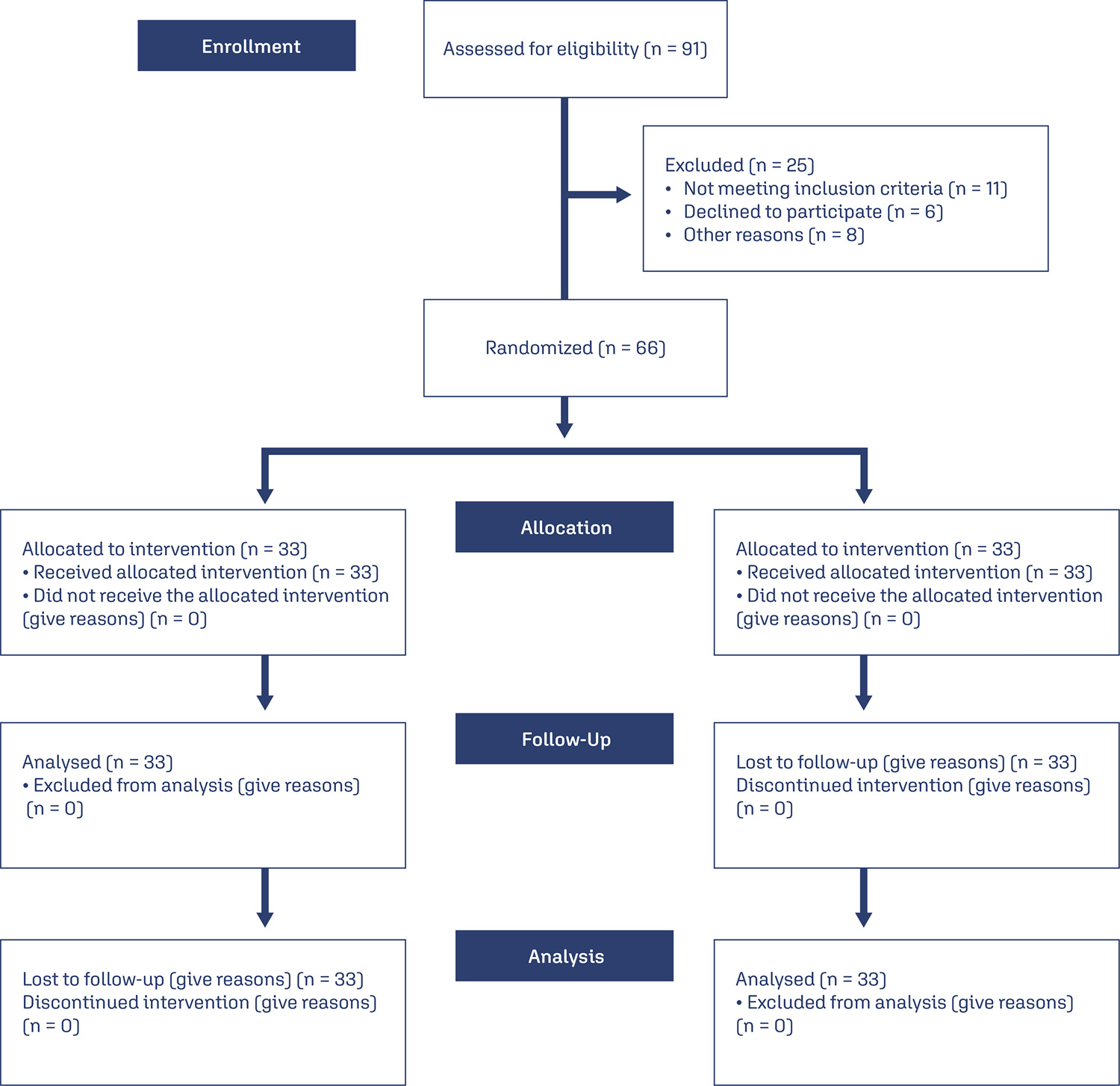
-
Original Article04-30-2025
Assessıng the predıctıve accuracy of blood-based bıomarkers ın neonatal outcomes for pregestatıonal dıabetes mellıtus
- Ayse Cigdem Bayrak
 ,
, - Erdem Fadiloglu
 ,
, - Haticegul Tuncer
 ,
, - Edip Alptug Kir
 ,
, - Umutcan Kayikci
 , [ … ],
, [ … ], - Ozgur Deren

Abstract
Original ArticleAssessıng the predıctıve accuracy of blood-based bıomarkers ın neonatal outcomes for pregestatıonal dıabetes mellıtus
Revista Brasileira de Ginecologia e Obstetrícia. 2025;47:e-rbgo17
- Ayse Cigdem Bayrak
 ,
, - Erdem Fadiloglu
 ,
, - Haticegul Tuncer
 ,
, - Edip Alptug Kir
 ,
, - Umutcan Kayikci
 ,
, - Ozgur Deren

Views68Abstract
Objective:
This retrospective study aimed to investigate blood-based immune-inflammatory biomarkers (IIBs) in predicting neonatal outcomes in pregnancies with pregestational diabetes mellitus (PGDM).PIV[(neutrophil×platelet×monocyte)/lymphocyte)], SII (neutrophil×platelet/lymphocyte), and NLR neutrophil/lymphocyte) values were evaluated in all three trimesters, and their correlation with neonatal outcomes was examined.
Methods:
We included 82 cases of PGDM pregnancies delivered after 32 weeks. Maternal age, gravidity, parity, types of diabetes, and route of delivery were noted. For neonatal outcomes, we recorded gestational age at birth, birth weight percentile, existence of fetal growth restriction, LGA, neonatal intensive care unit (NICU) requirement, Apgar Score <7 at 1, 5, or 10 minutes, need for positive pressure ventilation (PPV), need for mechanical ventilation, hypoglycaemia, hyperbilirubinemia and the need for phototherapy. PIV, SII and NLR values were calculated in each trimester and their association with adverse neonatal outcomes was analyzed.
Results:
We could not detect any consistent and significant correlation between SII and PIV values and adverse neonatal outcomes for each trimester. There was a correlation between 3rd trimester NLR and adverse neonatal outcomes, including APGAR <7, the requirement for PPV and mechanical ventilation (p=0.056, 0.013 and 0.060, respectively).
Conclusion:
While SII and PIV values did not consistently correlate with adverse neonatal outcomes throughout each trimester in PGDM pregnancies, 3rd-trimester NLR showed a notable association with the requirement for PPV with statistical significance and with Apgar Score <7 and the requirement for mechanical ventilation without statistical significance. NLR in the third trimester may hold potential as a predictive marker for specific adverse neonatal outcomes in PGDM pregnancies, warranting further investigation.
Key-words biomarkersDiabetes mellitusGestational ageHypoglycemiaInfant, newbornIntensive care units, neonatalLymphocytesMaternal ageMonocytesNeuthrophilsPregancyPregnancy in diabetesRespiration, artificialSee more

This is an Open Access article distributed under the terms of the Creative Commons Attribution License, which permits unrestricted use, distribution, and reproduction in any medium, provided the original work is properly cited. - Ayse Cigdem Bayrak
-
Original Article04-30-2025
Effects of domestic violence on menopausal symptoms, sexual function, and quality of life: a cross-sectional study
Revista Brasileira de Ginecologia e Obstetrícia. 2025;47:e-rbgo16
Abstract
Original ArticleEffects of domestic violence on menopausal symptoms, sexual function, and quality of life: a cross-sectional study
Revista Brasileira de Ginecologia e Obstetrícia. 2025;47:e-rbgo16
Views75Abstract
Objective:
To investigate the association between lifetime experience of domestic violence and climacteric symptoms, sexual function, and quality of life in climacteric women in Rio Grande do Sul, Brazil.
Methods:
A cross-sectional study was conducted with 700 pre-, peri-, and postmenopausal women, recruited online via an anonymous questionnaire (REDCap platform). Women aged 40 to 65 years, residing in Rio Grande do Sul, and classified by the STRAW+10 criteria were included. Climacteric symptoms and sexual function were assessed using the 10-item Cervantes Scale (CS-10) and the 6-item Female Sexual Function Index (FSFI-6). Data were analyzed using SPSS version 18.0; quantitative data as median [IQR], qualitative as frequencies. Group comparisons used Kruskal-Wallis, Chi-Square, and Spearman’s correlation between violence against women (VAW) and/or climacteric groups on CS-10 or FSFI-6. Significance was set at 5%.
Results:
The median [IQR] age of pre- (46 [43 – 50] years), peri- (50 [47 – 52] years), and postmenopausal (55 [51 – 58] years) were different among groups. Prevalence rates of psychological (38.8%), sexual (34.9%), and physical (21.3%) violence were observed. Postmenopausal women showed the poorest outcomes. Premenopausal women experiencing violence had severe anxiety, while postmenopausal women reported feeling worthless. Various sexual dysfunctions were associated with violence, including low desire, lubrication issues, and sexual pain.
Conclusions:
Domestic violence was linked to worse climacteric symptoms, sexual function, and quality of life, particularly in postmenopausal women. These findings underscore the need for improved care and public policies to enhance safety and well-being among women of all ages.
Key-words AnxietyClimactericDomestic violenceMenopausePostmenopauseQuality of lifeSexualitysurveys and questionnairesViolence against womenSee more

This is an Open Access article distributed under the terms of the Creative Commons Attribution License, which permits unrestricted use, distribution, and reproduction in any medium, provided the original work is properly cited. 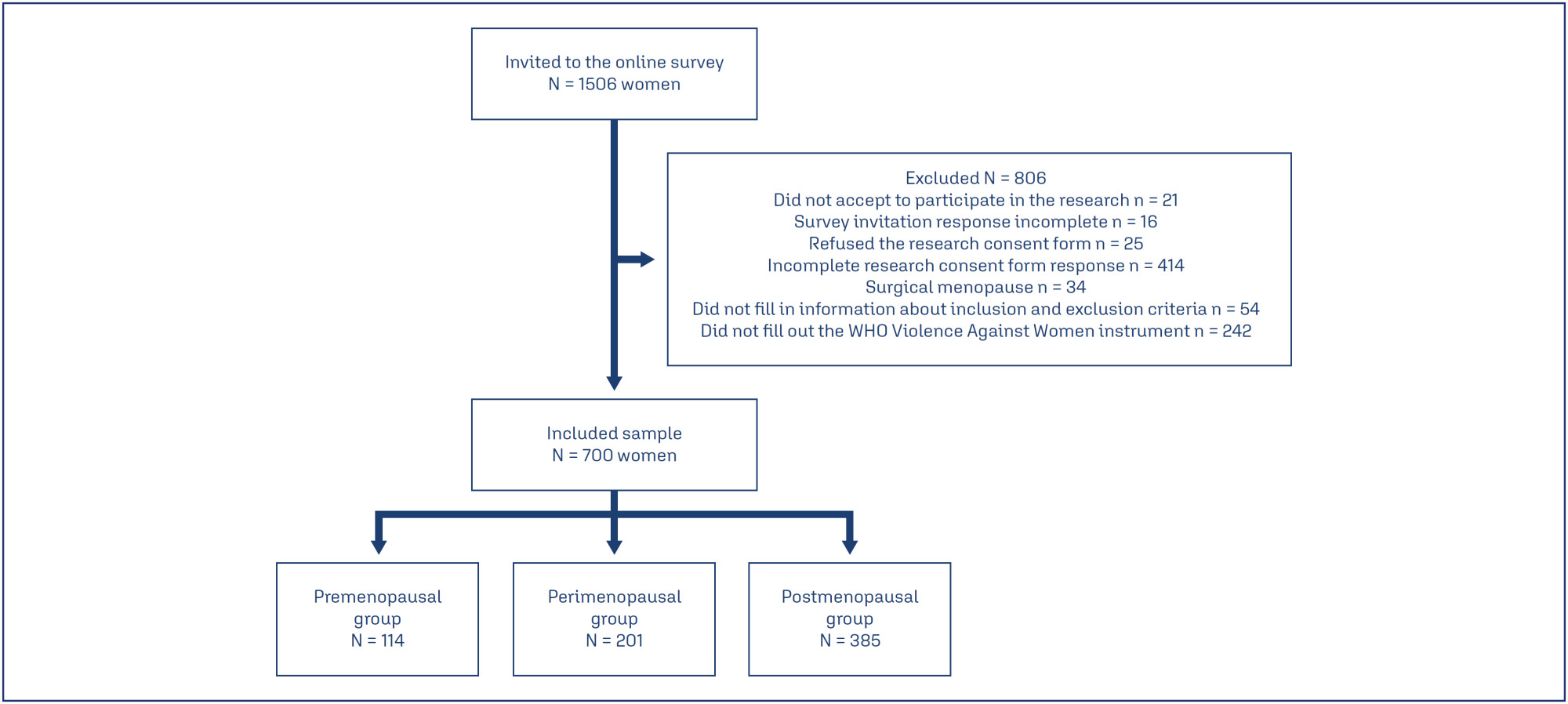
-
Original Article04-30-2025
The ımpact of demographic and obstetric factors on perception of traumatic birth and breastfeeding attitudes
Revista Brasileira de Ginecologia e Obstetrícia. 2025;47:e-rbgo15
Abstract
Original ArticleThe ımpact of demographic and obstetric factors on perception of traumatic birth and breastfeeding attitudes
Revista Brasileira de Ginecologia e Obstetrícia. 2025;47:e-rbgo15
Views49Abstract
Objective:
This study aims to examine the effects of sociodemographic and obstetric factors on traumatic birth perception and breastfeeding attitudes in primiparous mothers who have had a vaginal birth in the early postpartum period.
Methods:
The sample of the research, developed with a cross-sectional and correlational design, consisted of 252 women residing in a province in the Western Black Sea region of Türkiye. The data were obtained by employing a Personal Information Form, Traumatic Childbirth Perception Scale, and Breastfeeding Attitudes of The Evaluation Scale. Data analysis was conducted using the statistical programming language R (R version 4.3.3).
Results:
Women who were not employed, had a planned pregnancy, and did not experience health problems during pregnancy had higher mean breastfeeding attitude scores, and this difference was statistically significant. It was determined that a one-unit increase in gestational week led to an average increase of 1.926 units in breastfeeding attitude score, and a one-unit increase in Traumatic Childbirth Perception Scale score led to an average decrease of 0.110 units in breastfeeding attitude score. The mean traumatic childbirth perception scores of women living in urban areas were found to be lower than those living in villages or towns, and the difference was statistically significant.
Conclusion:
The research findings indicate that gestational age, perception of traumatic childbirth, and certain sociodemographic factors significantly affect breastfeeding attitudes. Additionally, mothers living in urban areas have a lower perception of traumatic childbirth. Therefore, individualized approaches to childbirth and breastfeeding support are crucial.
Key-words Breast feedingDelivery, obstetricParturitionperceptionPostpartum periodSociodemographic factorsStress disorders, post-traumaticSee more

This is an Open Access article distributed under the terms of the Creative Commons Attribution License, which permits unrestricted use, distribution, and reproduction in any medium, provided the original work is properly cited. 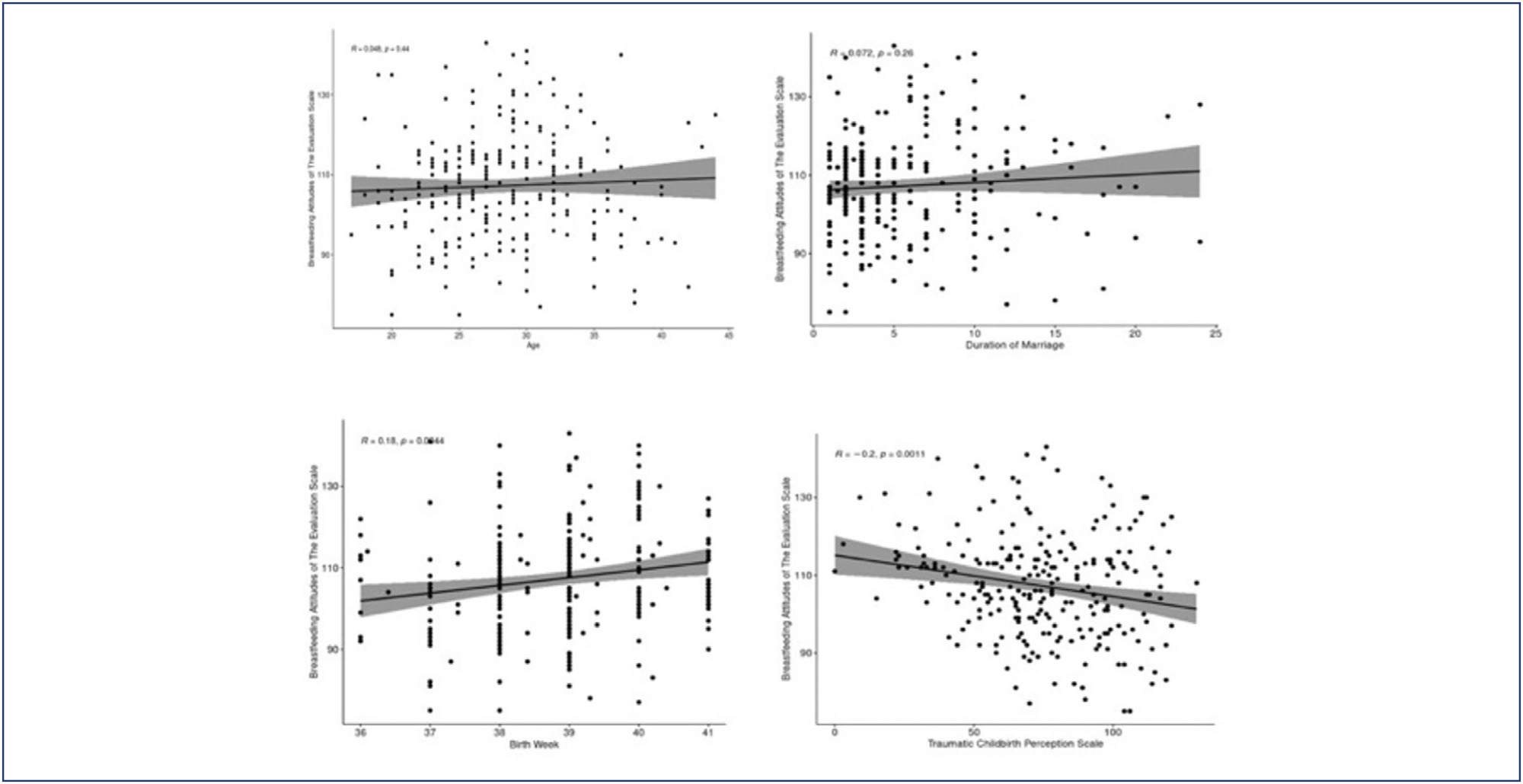
-
Original Article04-30-2025
Clinical and epidemiological profile of pregnant and postpartum women affected by COVID-19 who required respiratory support
- Carolina Maria Pires Cunha
 ,
, - Melania Maria Ramos Amorim
 ,
, - Julianna de Azevedo Guendler
 ,
, - Alex Sandro Rolland Souza
 ,
, - Leila Katz

Abstract
Original ArticleClinical and epidemiological profile of pregnant and postpartum women affected by COVID-19 who required respiratory support
Revista Brasileira de Ginecologia e Obstetrícia. 2025;47:e-rbgo14
- Carolina Maria Pires Cunha
 ,
, - Melania Maria Ramos Amorim
 ,
, - Julianna de Azevedo Guendler
 ,
, - Alex Sandro Rolland Souza
 ,
, - Leila Katz

Views50Abstract
Objective:
This study described the clinical and epidemiological profile and the management provided to pregnant and postpartum women with COVID-19 who required respiratory support.
Methods:
A descriptive study was conducted with pregnant and postpartum women with confirmed COVID-19 who received care between April 2020 and December 2021 in eight referral centers in northeastern Brazil. Statistical analysis was conducted using Epi-Info 7.2.5 and Medcalc, version 20.112.
Results:
Of the 720 patients admitted, 208 (32.7%) required respiratory support. Mean age of the participants was 28.9±7.1 years. Most (52.8%) were brown-skinned; 31.3% had little formal schooling; 41.1% had a personal income and 23.1% were married. Around half were referred from another hospital. Overall, 36.8% were obese and 36.9% were hypertensive. Criteria for severe acute respiratory syndrome (SARS) were present in 80.7% of cases. Overall, 151 patients (74.7%) required corticoids, and 150 (76.1%) were admitted to an intensive care unit. Non-invasive ventilation was needed in 89.4% of cases, with nasal catheters being the most common type (55.3% of cases). Invasive mechanical ventilation was necessary in 35.5% of cases and 91.6% had a cesarean section. Maternal near miss and death occurred in 24% and 12.9% of cases, respectively.
Conclusion:
Pregnant and postpartum women with COVID-19 who required respiratory support were predominantly brown-skinned, in the third trimester of pregnancy and had been referred from another hospital. The cesarean section rate was high; the presence of criteria for SARS was common and the rates of COVID-19-related maternal near miss and death were high.
Clinical Trials registry:
NCT04462367
Key-words Cesarian sectionCOVID-19Intensive care unitsNear miss, healthcareNoninvasive ventilationObesityPostpartum periodPregnancyPregnancy trimester, thirdRespiration, artificialSARS-CoV-2severe acute respiratory syndromeSee more

This is an Open Access article distributed under the terms of the Creative Commons Attribution License, which permits unrestricted use, distribution, and reproduction in any medium, provided the original work is properly cited. 
- Carolina Maria Pires Cunha
-
Original Article04-30-2025
Evaluation of pathological complete response rates in breast cancer patients undergoing neoadjuvant therapy
- Gabriella Ferezini Oliveira de Sá
 ,
, - Pedro Vilar de Oliveira Villarim
 ,
, - Pedro Hortêncio Saboia da Escossia Melo
 ,
, - Ayane Cristine Alves Sarmento
 ,
, - Ana Katherine Gonçalves
 , [ … ],
, [ … ], - Cristina Rocha de Medeiros Miranda

Abstract
Original ArticleEvaluation of pathological complete response rates in breast cancer patients undergoing neoadjuvant therapy
Revista Brasileira de Ginecologia e Obstetrícia. 2025;47:e-rbgo13
- Gabriella Ferezini Oliveira de Sá
 ,
, - Pedro Vilar de Oliveira Villarim
 ,
, - Pedro Hortêncio Saboia da Escossia Melo
 ,
, - Ayane Cristine Alves Sarmento
 ,
, - Ana Katherine Gonçalves
 ,
, - Kleyton Santos de Medeiros
 ,
, - Cristina Rocha de Medeiros Miranda

Views60See moreAbstract
Objective:
This study aims to assess the rate of pathological complete response (pCR) in breast cancer patients undergoing neoadjuvant therapy and to explore its correlation with clinical, molecular, and prognostic factors.
Methods:
We conducted this retrospective observational study at Liga Contra o Câncer, a major public oncology reference center in Northeast Brazil. We included patients diagnosed with breast cancer who initiated neoadjuvant therapy between June 2018 and June 2019. Patients with a history of recurrent breast cancer or those who did not undergo surgery were excluded. The primary outcome was the pCR rate, with secondary outcomes including Overall Survival (OS), Disease-Free Survival (DFS), mortality, and disease recurrence. Follow-up extended until August 2022. We performed multivariate Cox regression analysis to correlate outcomes with predetermined variables.
Results:
Of the 292 included patients, 63 (21.6%) achieved pCR. The mean follow-up duration was 42.8 months. Multivariate logistic regression analysis revealed an association between pCR and the AC-TH regimen [OR = 2.4; 95%CI = 1.13 – 5.24; p=0.023], as well as between pCR and HER2-positive tumors [OR 2.49; 95% CI = 1.14 – 5.86; p=0.028]. Complete pathological response was associated with higher DFS [HR 0.33; 95%CI 0.13-0.86; p=0.024].
Conclusion:
Neoadjuvant therapy demonstrated significant efficacy in achieving pathological response in breast cancer patients. We observed a strong association between the AC-TH regimen, HER2-positive status, and pCR.


This is an Open Access article distributed under the terms of the Creative Commons Attribution License, which permits unrestricted use, distribution, and reproduction in any medium, provided the original work is properly cited. 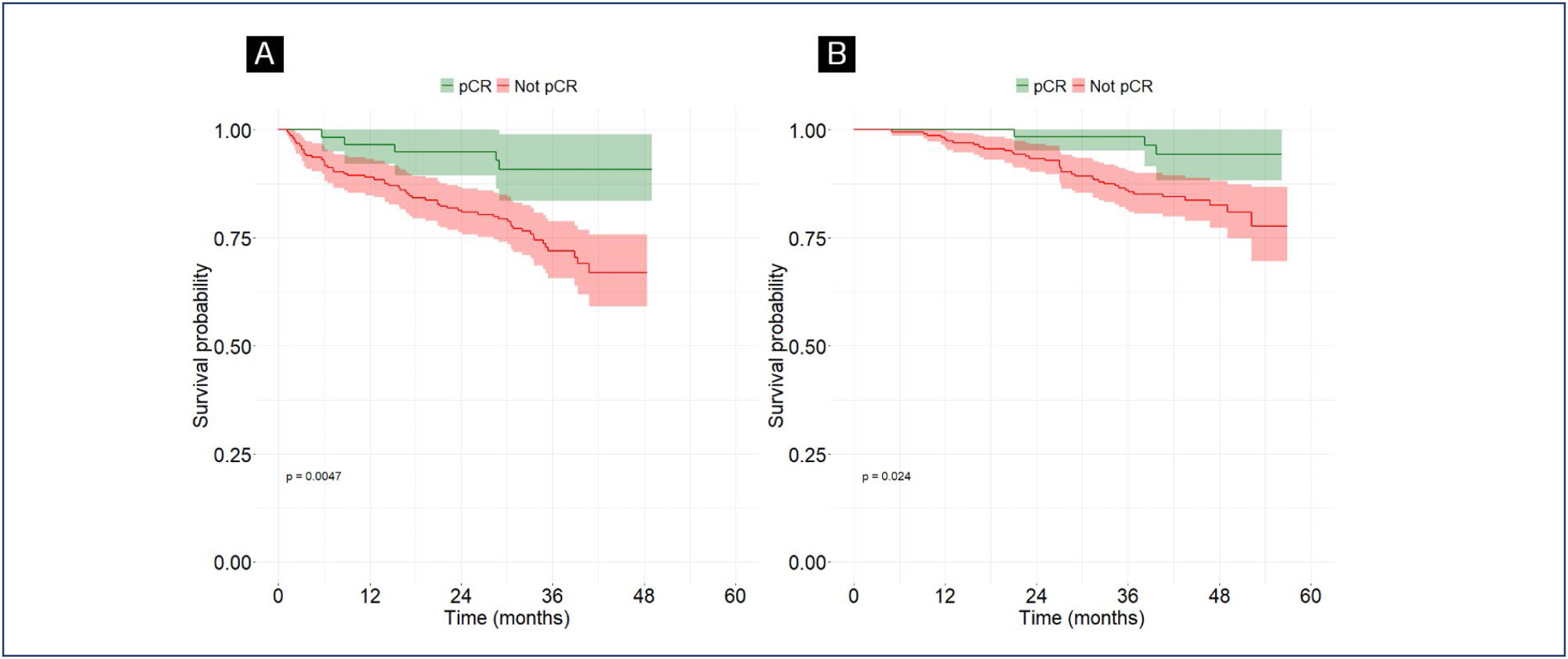
- Gabriella Ferezini Oliveira de Sá
-
FEBRASGO POSITION STATEMENT03-28-2025
Follow-up of women after gynecological cancer treatment
- Agnaldo Lopes da Silva Filho
 ,
, - Mariana Seabra Leite Praça
 ,
, - Matheus Eduardo Soares Pinhati
 ,
, - Laura Guimarães Castro
 ,
, - Renato Moretti-Marques
 , [ … ],
, [ … ], - Eduardo Batista Cândido

Abstract
FEBRASGO POSITION STATEMENTFollow-up of women after gynecological cancer treatment
Revista Brasileira de Ginecologia e Obstetrícia. 2025;47:e-FPS3
- Agnaldo Lopes da Silva Filho
 ,
, - Mariana Seabra Leite Praça
 ,
, - Matheus Eduardo Soares Pinhati
 ,
, - Laura Guimarães Castro
 ,
, - Renato Moretti-Marques
 ,
, - Angélica Nogueira-Rodrigues
 ,
, - Eduardo Batista Cândido

Views176See moreKey points
•The population of female cancer survivors has increased over the last few years, highlighting the importance of appropriate follow-up of these patients.
•The main objective of long-term follow-up for patients treated for cancer is the early detection of recurrences, whether local, lymph node or distant metastases.
•Symptom assessment and physical examination play an important role in the follow-up of patients treated for gynecological neoplasms.
•The use of laboratory or imaging tests to detect recurrence in asymptomatic patients should be based on evidence that it improves survival or provides less morbid treatments, also considering cost and availability.


This is an Open Access article distributed under the terms of the Creative Commons Attribution License, which permits unrestricted use, distribution, and reproduction in any medium, provided the original work is properly cited. - Agnaldo Lopes da Silva Filho
-
Letter to the Editor03-18-2025
Comment on: Access and adequacy of antenatal care in during two phases of the COVID-19 pandemic
Revista Brasileira de Ginecologia e Obstetrícia. 2025;47:e-rbgo12
Abstract
Letter to the EditorComment on: Access and adequacy of antenatal care in during two phases of the COVID-19 pandemic
Revista Brasileira de Ginecologia e Obstetrícia. 2025;47:e-rbgo12
Views176The publication on “Access and adequacy of antenatal care in a city in Brazil during two phases of the COVID-19 pandemic.”() Is an interesting issue. This study investigated antenatal care consumption and appropriateness among postpartum caregivers at Florianópolis Hospital from 2020 to 2022, with an emphasis on socio-demographic characteristics and antenatal care. Although this study […]See more

This is an Open Access article distributed under the terms of the Creative Commons Attribution License, which permits unrestricted use, distribution, and reproduction in any medium, provided the original work is properly cited. -
Letter to the Editor03-18-2025
Use of calcium during pregnancy: far beyond pre-eclampsia
- Melania Maria Ramos Amorim
 ,
, - Marina Amorim Albuquerque
 ,
, - Lucas Félix
 ,
, - Anna Catharina Carneiro da Cunha
 ,
, - Leila Katz

Abstract
Letter to the EditorUse of calcium during pregnancy: far beyond pre-eclampsia
Revista Brasileira de Ginecologia e Obstetrícia. 2025;47:e-rbgo11
- Melania Maria Ramos Amorim
 ,
, - Marina Amorim Albuquerque
 ,
, - Lucas Félix
 ,
, - Anna Catharina Carneiro da Cunha
 ,
, - Leila Katz

Views191Dear Editor,We read with interest the Editorial of the Revista Brasileira de Ginecologia e Obstetrícia (RBGO) in which Braga et al. present the initiative of the state of Rio de Janeiro (Brazil) for prediction and secondary prevention of pre-eclampsia.() The authors highlight universal calcium supplementation during pregnancy as a significant innovation, implemented for the first […]See more

This is an Open Access article distributed under the terms of the Creative Commons Attribution License, which permits unrestricted use, distribution, and reproduction in any medium, provided the original work is properly cited. - Melania Maria Ramos Amorim
Search
Search in:
Tag Cloud
Pregnancy (252)Breast neoplasms (104)Pregnancy complications (104)Risk factors (103)Menopause (88)Ultrasonography (83)Cesarean section (78)Prenatal care (71)Endometriosis (70)Obesity (61)Infertility (57)Quality of life (55)prenatal diagnosis (51)Women's health (48)Postpartum period (46)Maternal mortality (45)Pregnant women (45)Breast (44)Prevalence (43)Uterine cervical neoplasms (43)
